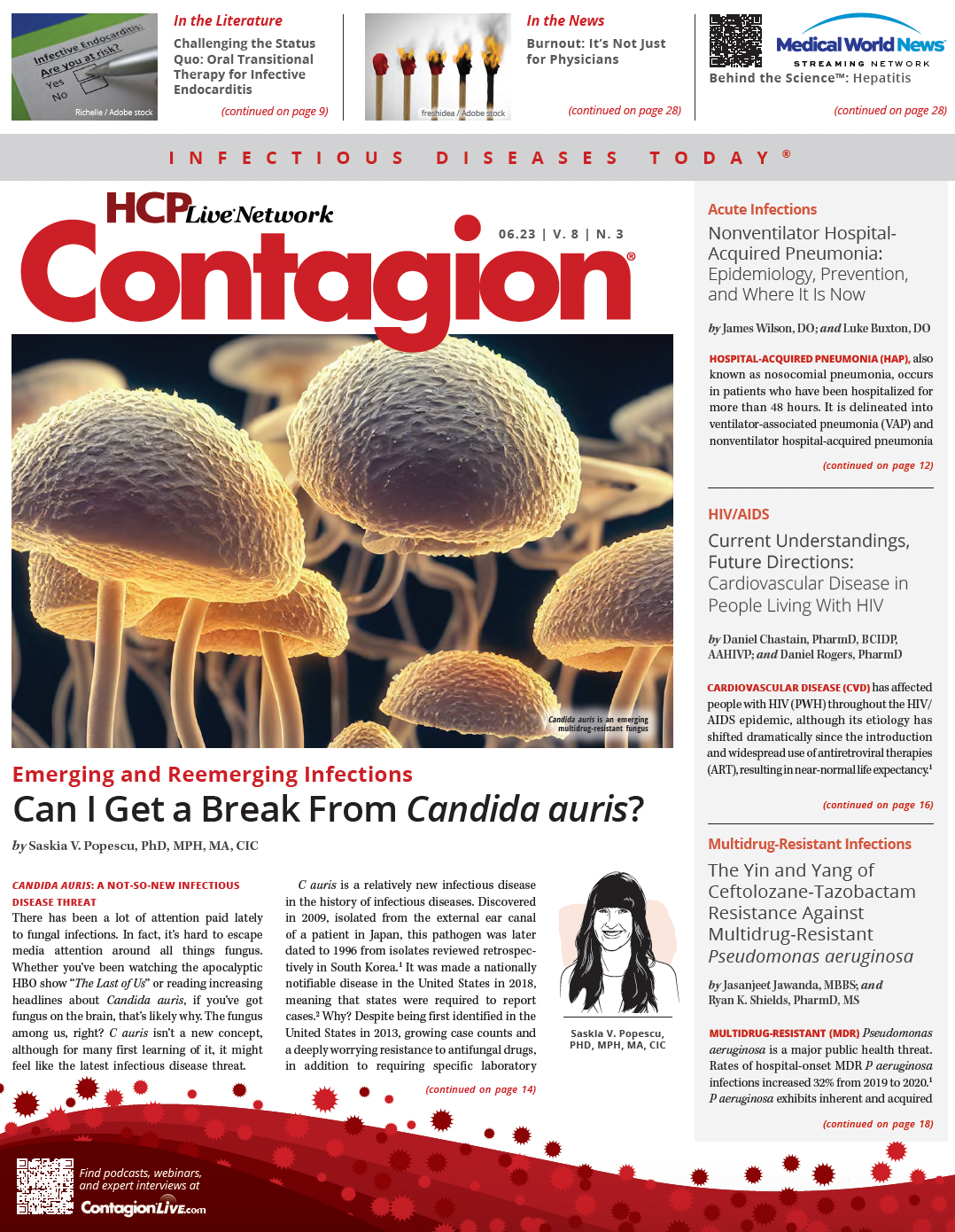Challenging the Status Quo: Oral Transitional Therapy for Infective Endocarditis
New evidence suggests that oral transitional therapy may be a promising option for the treatment of infective endocarditis (IE). A retrospective cohort study reveals comparable clinical outcomes between oral and intravenous antibiotic regimens.

Although relatively uncommon, infective endocarditis (IE) is a disease with considerable morbidity and mortality.1
IE occurs when a bacterial or fungal pathogen enters the blood and attaches to the inner lining of the heart (the endocardium), usually a heart valve. The estimated annual incidence of IE ranges from 3 to 7 cases per 100,000 person-years.1 Standard treatment regimens for the disease typically require at least 4 weeks of antimicrobial therapy, largely administered intravenously.1
Although intravenous (IV) administration of antimicrobial therapy confers certain benefits such as complete bioavailability, its use does not preclude risk.2 Prolonged IV antimicrobial therapy can result in increased hospital length of stay (LOS) and health care costs.3 Furthermore, IV therapies pose risk of potentially serious complications, including phlebitis and extravasation.3
Despite the abundance of recommendations available for initial management of IE, literature supporting use of oral transitional therapy in IE has been limited until recently.2,4 In one of the largest randomized controlled trials to date, oral step-down antibiotic therapy was found to be noninferior to prolonged IV antibiotic therapy in patients with stable left-sided IE.4
Use of oral regimens in patients with reliable gastrointestinal absorption and medication adherence offers numerous benefits, including the possibility of reduced hospital LOS and catheter-related infections.2 Nonetheless, adoption of oral transitional therapy for IE in clinical practice is slow-moving, warranting the need for research exploring real-world outcomes.5
The retrospective cohort study conducted by Freling et al compared outcomes for patients receiving IV-only vs oral transitional treatment for IE at 3 acute care hospitals within the Los Angeles County Department of Health Services. Patients with definite or possible IE per Duke criteria were included in this study. Relevant exclusion criteria included patients with inadequate chart documentation, those with blood cultures obtained from nonclinical sources or acquired outpatient without follow-up, and patients who died prior to oral transitional treatment.
Data were collected through chart review of electronic medical records. Patients were assigned to an IV-only or oral transitional treatment arm based on antibiotic route of administration at hospital discharge.
The primary efficacy end point was clinical success. This was defined as 90-day survival without recurrent bacteremia and treatment-emergent infectious complications. Clinical success at follow-up, hospital LOS, and hospital readmission rates were notable secondary outcomes assessed.
Overall, 257 patients (211 patients in the IV-only cohort and 46 patients in the oral transitional cohort) were included for analysis. Despite similarities in IE classification, there were noteworthy differences between treatment arms. A higher proportion of patients in the IV-only treatment arm were older with diabetes mellitus, dialysis dependence, aortic valve involvement, and central venous catheters present at diagnosis. Meanwhile, a greater percentage of patients in the oral transitional treatment arm had tricuspid valve involvement and a history of injection drug use.
Of patients with infections caused by Staphylococcus aureus, a higher proportion of cases in the oral transitional treatment arm were due to methicillin-resistant S aureus compared with the IV-only treatment arm (34.8% vs 20.4%; P = .04). Additionally, among patients receiving oral treatment, linezolid was administered to 65.2% of patients, representing the predominant oral antibiotic used. In the oral transition cohort, patients received an average of 15.5 days of IV therapy prior to initiating oral therapy.
Rates of clinical success were comparable between IV-only and oral transitional treatment arms at 90-day follow-up (84.4% vs 87.0%, respectively; P = .66). These results persisted at last follow-up (82.0% vs 76.1%, respectively; P = .36). Similarly, there were no statistically significant differences in median length of inpatient stay (16 vs 14.5 days; P = .20) or 90-day readmission rates (34.1% vs 26.1%; P = .29) between the IV-only and oral transitional treatment arms, respectively.
The median total duration of antibiotic therapy for both groups was 42 days. Moreover, no significant associations were found between study outcomes and key demographic variables in multivariable logistic regression models. Regarding adverse events, a statistically significant greater number of events were observed in the IV-only arm compared with the oral transitional treatment arm (27.5% vs 8.7%; P = .004). Higher rates of acute kidney injury (10.9%; P = .048) and IV line–related adverse events (17.0%; P = .04) were noted in the IV-only treatment arm.
This study adds to a growing body of evidence concerning the use of oral therapy in IE. In general, similar rates of clinical success were observed between groups. However, several factors may have impacted these results. Factors include the higher rates of diabetes mellitus, dialysis-dependent end-stage renal disease, and left-sided disease observed in patients in the IV-only arm and the greater percentage of IV drug use and methicillin-resistant S aureus infections noted among patients receiving oral transitional therapy.
Unsurprisingly, rates of adverse events—specifically IV-related events—were observed in patients receiving IV-only therapy. This result could potentially be attributed to the prevalence of patients in this cohort with dialysis dependance and central venous catheters. Nevertheless, this finding aligns with contemporary data that suggest an increased risk of complications from prolonged IV catheterization.6
Although this study successfully demonstrates comparable outcomes between IV and oral transitional therapy in clinical practice, there were some notable shortcomings. First, this study was retrospective in nature and thus dependent on accurate and complete chart documentation. This limitation is further highlighted by study authors who noted the possibility of patients with recurrent IE being counted more than once based on discharge regimens for subsequent episodes captured in the electronic medical record.
Second, although appropriate statistical adjustments were made to control for confounding effects, the possibility still exists of unrecognized or unknown factors that may have influenced results.
Last, this study was conducted at multiple centers within the same health system, potentially limiting its applicability to clinical practice at health systems in other geographic regions. Even with these drawbacks, this study underscores the importance of additional data evaluating the utility of oral therapy in IE.
References
- Baddour LM, Wilson WR, Bayer AS, et al; American Heart Association Committee on Rheumatic Fever, Endocarditis, and Kawasaki Disease of the Council on Cardiovascular Disease in the Young; Council on Clinical Cardiology; Council on Cardiovascular Surgery and Anesthesia; Stroke Council. Infective endocarditis in adults: diagnosis, antimicrobial therapy, and management of complications: a scientific statement for healthcare professionals from the American Heart Association. Circulation. 2015;132(15):1435-1486. doi:10.1161/CIR.0000000000000296
- Brown E, Gould FK. Oral antibiotics for infective endocarditis: a clinical review. J Antimicrob Chemother. 2020;75(8):2021-2027. doi:10.1093/jac/dkaa106
- Li HK, Agweyu A, English M, Bejon P. An unsupported preference for intravenous antibiotics. PLoS Med. 2015;12(5):e1001825. doi:10.1371/journal.pmed.1001825
- Iversen K, Ihlemann N, Gill SU, et al. Partial oral versus intravenous antibiotic treatment of endocarditis. N Engl J Med. 2019;380(5):415-424. doi:10.1056/NEJMoa1808312
- Freling S, Wald-Dickler N, Banerjee J, et al. Real-world application of oral therapy for infective endocarditis: a multicenter retrospective, cohort study. Clin Infect Dis. Published online March 7, 2023. doi:10.1093/cid/ciad119
- Spellberg B, Chambers HF, Musher DM, Walsh TL, Bayer AS. Evaluation of a paradigm shift from intravenous antibiotics to oral step-down therapy for the treatment of infective endocarditis: a narrative review. JAMA Intern Med. 2020;180(5):769-777. doi:10.1001/jamainternmed.2020.0555

